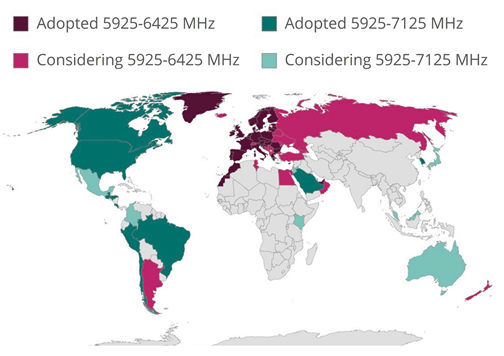Wi-Fi 6E: What and Where
Wi-Fi 6E is an extension of the Wi-Fi 6 specification that incorporates products that support the 6 GHz wireless spectrum. To explain, all Wi-Fi 6 products support both the 2.4 GHz and 5 GHz spectrums (see Fig. 2 below). But only Wi-Fi 6E devices also support the 6 GHz spectrum.
The availability of the 6 GHz bandwidth is decided on a country-by-country basis. While the US, Canada, and European Union have opened up the 6GHz band for 6E usage, support from other countries, particularly in Asia and Africa, is nascent. Figure 1 shows existing support as of December 2021 from this Wi-Fi Alliance link.
Figure 1. Countries Enabling Wi-Fi 6E | Wi-Fi Alliance (link)
As Figure 2 shows, the 2.4 GHz and 5 GHz bands contain many fewer channels and fewer high-speed channels than the 6 GHz spectrum. Because all Wi-Fi 6 devices (and many previous generations) use these channels, there’s more contention for this bandwidth, not only within your home or office but also from nearby networks that communicate over the same spectrum.
Figure 2. Wi-Fi 6E adds the 6 GHz spectrum, with more channels and less bandwidth contention. Image from Wi-Fi 6E: The New Spectrum with 6 GHz Band (volansys.com)
In the US, Canada, and some Latin American countries, the 6 GHz frequency band provides 1200 MHz of spectrum which comprises an additional fourteen 80 MHz channels or an additional seven 160 MHz channels, as shown in Fig. 2. This means faster connections and less interference from other devices.
The 6 GHz frequency band will improve Wi-Fi performance by enabling:
Higher concurrency
– The 6 GHz frequency band provides an additional 1200 MHz of spectrum resources, which is more than the total resources provided by the 2.4 GHz and 5 GHz frequency bands. This alleviates channel congestion and enables more simultaneous users, improving the concurrency rate.
High bandwidth
– Although 160 MHz channels can run on the 2.4 GHz and 5 GHz frequency bands, there is generally too much traffic on these bands to provision a 160 MHz channel. The seven additional 160 MHz channels in the 6 GHz frequency should enable more of these high-speed connections, improving bandwidth.
Low latency
- Conventional Wi-Fi devices support only the 2.4 GHz and 5 GHz frequency bands. The 6 GHz frequency band is supported only by Wi-Fi 6E devices, which should mean lower traffic and lower latency.
As a caveat, note that 6 GHz uses shorter wavelengths, which work well for data transfers but may face degradation of the transmitted signal over longer distances or outdoors and may not perform as well through obstructions like walls and floors in a building. So, if you’re video conferencing with a direct line of sight of the 6E router; performance should be fabulous. If you’re behind a brick wall, you may get better performance from the 5 GHz or even 2.4 GHz spectrums.
Since 6E is relatively new, products that support the 6GHz spectrum are more expensive today. However, if you want to future-proof your Wi-Fi investments, they are probably worth it. Overall, Wi-Fi 6E is another example of how continued investments in Wi-Fi-related R&D deliver additional functionality and performance to Wi-Fi users.
Photo by Sigmund on Unsplash

